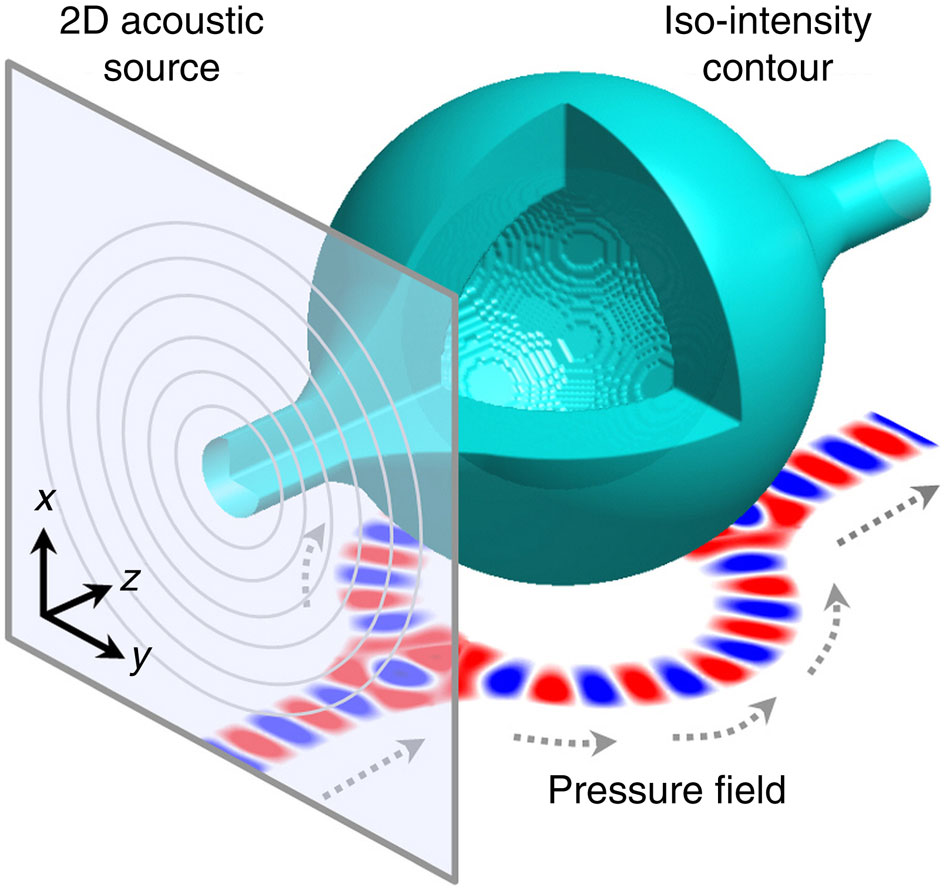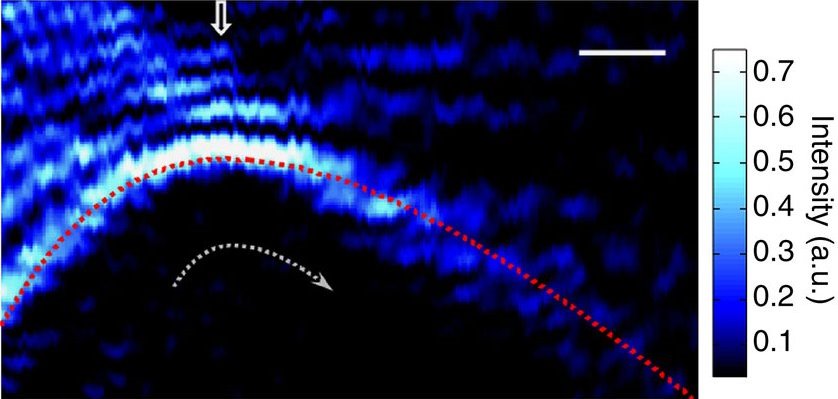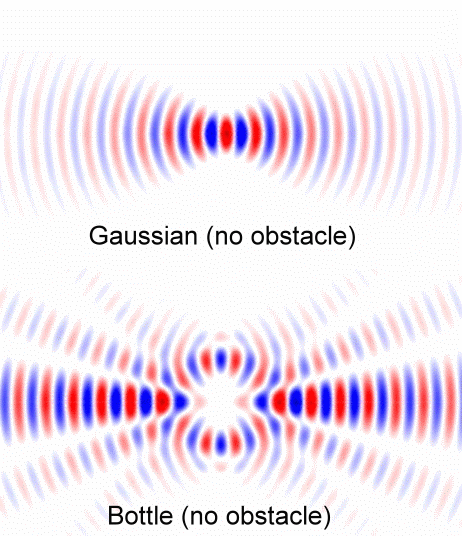Virtual acoustic ‘bottle’ bends path of sound waves better than metamaterials
August 6, 2014

After being emitted from a 2D (flat plane) phased source, sound energy forms a 3D acoustic “bottle” of high-pressure walls and a null (empty) region in the middle. The pressure field diagram at the bottom shows the self-bending ability of the “bottle” to weave around 3D obstacles. (Credit: Xiang Zhang group)
Lawrence Berkeley National Laboratory (Berkeley Lab) researchers have developed a technique to generate an acoustic bottle-like “object” in open air from sound. The virtual object can bend the paths of sound waves along prescribed convex trajectories.
The new technique could allow for super-high-resolution imaging, acoustic cloaking (without requiring engineered metamaterials), and other exotic applications.
As shown in the illustration above, the acoustic “bottle” is in the form of a 3D curved shell. A wall of high acoustic pressure surrounds a null (zero) pressure region in the middle.
The sound waves are generated by a planar (2D) array of loud speakers, 1.5 centimeters in diameter and spaced 2.5 centimeters apart, operating at a frequency of 10 kiloHertz (kHz) (10,000 vibrations per second — a high-pitched sound). The virtual “bottle” object is formed by precisely adjusting the phase (timing) profile of the speaker array.

This shows the trajectory (red-dashed curve) and the propagation direction of the beam (gray dashed curve). Scale bar = 0.1 meter. (Credit: Xiang Zhang group)
Applications
According to the researchers:
- The high-pressure wall of the acoustic bottle exerts a pulling force, so there are no sound waves passing through the null pressure interior of the bottle. That means the bottle can be used for acoustic trapping, even if there’s something placed inside the bottle.
- It can access hard-to-reach objects hidden behind obstacles, such as acoustic imaging, therapeutic ultrasound, and it can act as a cloaking device, re-routing sound waves around an object and then recovering them in their original form, making the object invisible to sonar detection. (Artificial “metamaterials” have been engineered that can bend sound waves sufficiently but the nature of these materials places limits on their applications, especially for biological purposes.)
- It might allow for acoustic levitation, in which sound waves are used to lift and manipulate millimeter-sized objects, including particles, microorganisms, and droplets of water, but with better stability, true 3D graphics, and more freedom of motion because the beam can propagate along a curved path. It can levitate much larger 3D objects than can be lifted and manipulated with other acoustic levitation techniques.
- It could lead to new technologies and devices for a variety of applications in chemistry, materials, and biosciences, such as a micro-chemical reactor and manipulation of biological trafficking devices.
- Since the principle of adjusted phased arrays is well established and used in ultrasound imaging, the acoustic bottle beam technique can be applied to current acoustic systems.
A Nature Communications paper describes this research, which was supported by the Office of Naval Research’s MURI program.

This animation shows the self-bending dynamics and obstacle-circumventing capabilities of the acoustic bottle field compared to a Gaussian beam. Sound energy can be seen flowing through the curved shell of the bottle. (Credit: Xiang Zhang group)
Abstract of Nature Communications paper
Directing acoustic waves along curved paths is critical for applications such as ultrasound imaging, surgery and acoustic cloaking. Metamaterials can direct waves by spatially varying the material properties through which the wave propagates. However, this approach is not always feasible, particularly for acoustic applications. Here we demonstrate the generation of acoustic bottle beams in homogeneous space without using metamaterials. Instead, the sound energy flows through a three-dimensional curved shell in air leaving a close-to-zero pressure region in the middle, exhibiting the capability of circumventing obstacles. By designing the initial phase, we develop a general recipe for creating self-bending wave packets, which can set acoustic beams propagating along arbitrary prescribed convex trajectories. The measured acoustic pulling force experienced by a rigid ball placed inside such a beam confirms the pressure field of the bottle. The demonstrated acoustic bottle and self-bending beams have potential applications in medical ultrasound imaging, therapeutic ultrasound, as well as acoustic levitations and isolations.